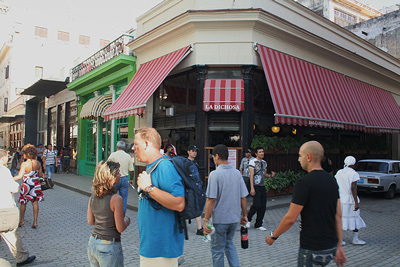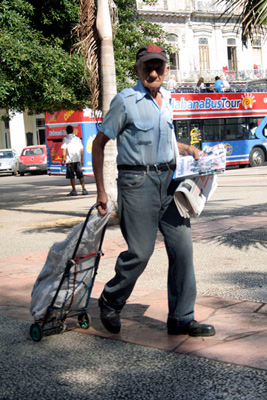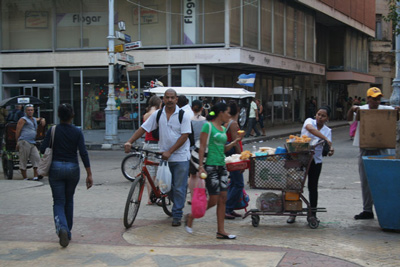Two Pedestrian Boulevards, Two Havanas
Daisy Valera

HAVANA TIMES — Havana’s Parque Central and the terrace between the old Asturian Cultural Center and the future Manzana Hotel are the spaces separating the San Rafael and Obispo pedestrian boulevards.
Obispo and its Café Europa were the stage of some of the most important political and philosophical soirées of the 19th century. San Rafael is the street where lager beer was first dispensed in all of Cuba.
The two walkways are connected by what is perhaps the city’s one continuous urban corridor. There, our distinguished “motorized citizens” come to a halt and “out-and-about Cubans” stroll phlegmatically down the street, ignoring the sounds of car horns and hurling near-vengeful glances at the drivers.
San Rafael pours into the humble neighborhoods at the heart of the capital and Obispo extends all the way up to the bay area, to the place where foreign visitors predictably aim their cameras at architect Jilma Madera’s towering Christ.

Though both are the most frequented shop-lined streets in the city, quite possibly they have in common only one thing: the frantic pace of pedestrians, their scrambling towards the shaded side of the street and panhandlers (who walk away with greater dividends if they set up camp on Obispo).
The “Revolutionary Offensive” of the early 1960s, followed by the State’s inability to manage small-scale commercial activity, culminated with the virtual annihilation of every charm these two boulevards in Havana had.
The restoration of Obispo street did not begin until 1993, when Decree Law No. 143, which turned the thoroughfare into an area of great importance for the country’s tourism industry, was implemented. The San Rafael boulevard hasn’t been so lucky, and, today, few remember that, in the 1930s, it had eclipsed Obispo with its many modern department stores.
The Obispo boulevard is the gate through which foreign visitors enter the city and the peephole through which Cubans try to make out a bright beyond of abundance.
Down this street, tourists stand in long lines before currency exchange offices. They allow themselves to be impressed by son or rumba rhythms, buy T-shirts with pictures of Che Guevara on them, books about the Bay of Pigs Invasion, black-market cigars and rum. At night, they continue buyin: a daiquiri, a swing of the hips – Obispo is today’s street of sin, like the intersection of San Rafael and Galiano once was.
Cubans go into its specialty stores to enjoy the air-conditioned ambiance. Sometimes, they pick up a garment, try it on and (in 90 % of cases) put it back on the hanger. They notice that one doesn’t have to wait in line for hours at the Almendares optician’s in order to get an eye test, and that there are sophisticated and comfortable beauty salons where a haircut costs more than the average salary.

The San Rafael boulevard, in contrast, has two peculiar features: one public bathroom and the renowned Rex Cinema, which has been transformed into a warehouse where the carts used by garbage collectors are stored.
Down San Rafael, where Cuban-peso thrift and hardware stores offering standard mass items thrive, people can afford to buy things. There, Cubans buy five-Cuban-peso soap and used clothing. There are gigantic mannequins dressed in denim, floral blouses, sacks, everything recalling 80s fashion.
Obispo awakens the anxious desire to buy and San Rafael channels these impulses.
These two boulevards are designed to guarantee Havana’s dynamic equilibrium. Here, tourists discover a warm and happy land, and the residents of Havana are less prone to dismiss as a pipedream the idea that the city is being reborn.






A good “compare and contrast” essay, Daisy! I always enjoy shopping in San Rafael, (or Jose Saco in Santiago, Independencia Sur in Sancti Spiritus, El Bulevar in Ciego de Avila, General Garcia in Bayamo, etc.) often in CUPS, and where, at the street stalls, I bargain. With their reasonable prices, I return home loaded with tchotchkes for my friends, objets ‘d art for my walls and shelves, and clothes, such as Industriales gorros and pulovers, for myself.. Also, the street food is great (or, if sometimes is the case, later, if you feel like you’re being punched in the stomach and have to run frequently to the bano, not so great!)